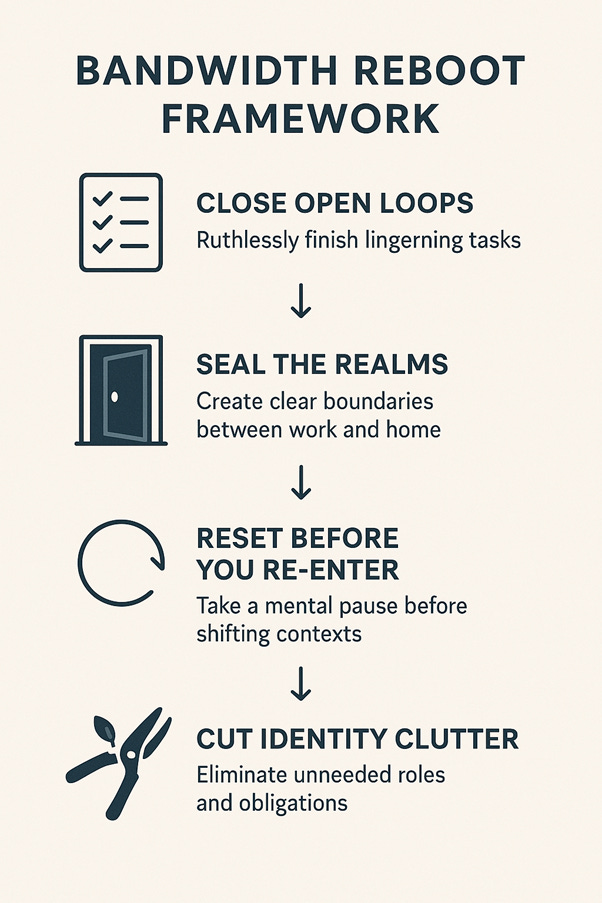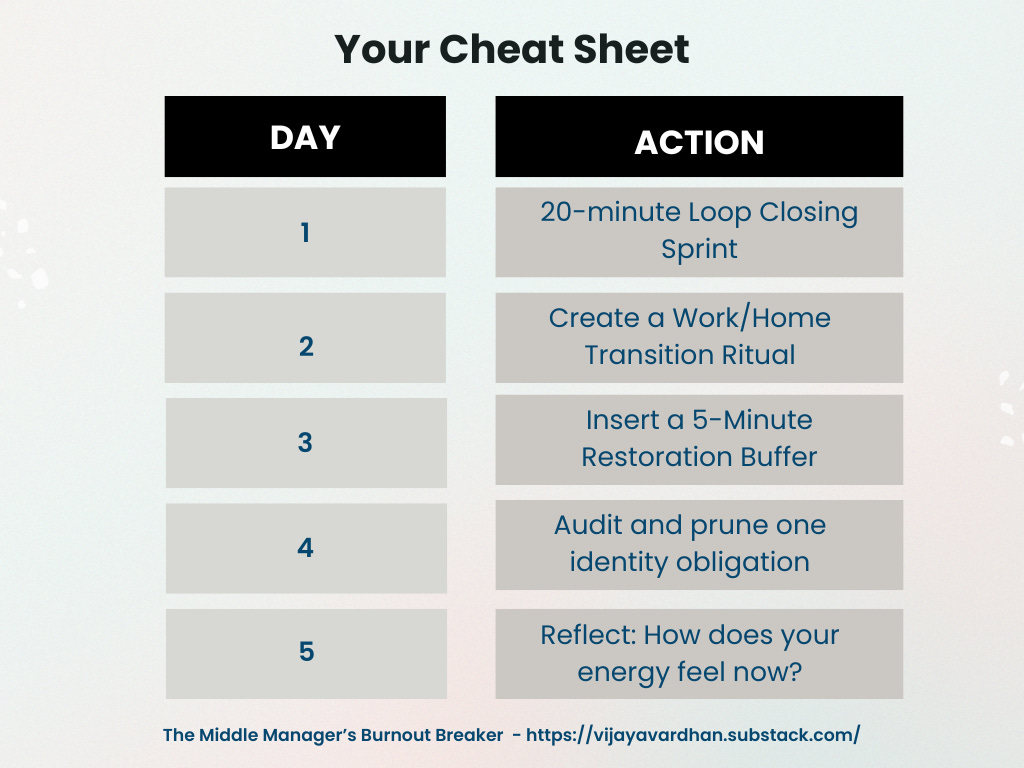You’re Not Burnt Out. You’re Mentally Full
You don’t need better time management. You need to unload the invisible weight you're carrying.
This weekend, we’ve got a special one.
A guest post by someone who’s walked the fire—and figured out how to stop getting burned.
Meet
—an operations leader with 21 years of battle-tested experience leading teams from 10 to 200+.He’s been in the trenches with middle managers and built a proven system for escaping the soul-sucking, career-stalling cycle we all know too well.
He’s not just another leadership voice spouting clichés—he’s lived through the frustration of feeling stuck, the quiet rage of being overlooked, and the grind of trying to do more with less… until he found a better way.
In today’s guest post, Vijaya flips the whole “work-life balance” conversation on its head—and shows why most of the advice we’ve been given is useless (at best) and destructive (at worst).
So, if you’ve ever: taken a vacation but still felt fried, been physically home but mentally back at the office, or thought, “I’m doing all the right things—so why the hell am I still exhausted?” …this is for you.
Read it. Reread it. Then forward it to that one colleague who also needs this today.
If you feel like you’re “off” even when you’re off the clock… you’re not broken.
You’re carrying an invisible load that’s draining your best energy—and stealing it from the people you love.
Let’s get brutally honest:
You’re not just tired.
You’re mentally full.
You don’t “lack motivation.”
You lack bandwidth.
You’re not failing at work-life balance.
You’re fighting a silent war against constant cognitive overload, and most of the advice you’re getting (“prioritise better,” “self-care more”) is like handing a leaking bucket to a drowning man.
You’re a high performer.
You can juggle tasks.
You can handle stress.
But here’s the part no one tells you:
Handling stress isn't the same as healing from it.And the longer you carry the invisible load without resetting your mental bandwidth, the more you become a ghost version of yourself, at work and home.
You know the feeling:
You’re sitting with your family, but your mind is replaying work.
You’re playing with your kids, but your brain is writing emails in the background.
You’re technically present… but emotionally absent.
This isn't a time management problem.
It’s an energy debt problem.
And it’s time to wipe the slate clean.
The Real Enemy: The Invisible Load
Before we dive into solutions, let’s define the real problem:
The Invisible Load
All the open tabs running in your mind, quietly draining your mental RAM.
It's the background worry about the client project.
The silent tension about the leadership meeting.
The unspoken guilt about spending “enough” time with your family.
The 37 half-finished mental checklists you carry even during your so-called downtime.
Every “little thing” you’re tracking costs you something.
One or two? No problem.
But stack enough invisible tasks—and it’s like trying to run a marathon with an anchor tied to your waist.
The ugly truth?
It’s not the BIG tasks that burn you out.
It’s the 10,000 small ones you never let go of.
The Bandwidth Reboot Framework™
To reclaim your energy without quitting your job or “working harder on balance,” you should treat your mental bandwidth like a non-negotiable asset.
Here’s the 4-part framework I teach high-performing managers:
This isn’t about working less.
It’s about carrying less.
Let's break it down.
1. Close Loops
Open loops are unfinished tasks, conversations, or promises still buzzing in your brain.
Each one eats a tiny slice of your mental attention—even when you’re not actively thinking about it.
Mental bandwidth = Total Capacity – Open Loops.The more loops you leave open, the less bandwidth you have.
Practical Move:
Set a 20-minute "Loop Closing Sprint" twice a week.
During this sprint:
Finish micro-tasks that take < 5 minutes
Formally defer (calendar block) bigger tasks
Or declare the loop dead (cancel without guilt)
You'll be shocked how light you feel just wiping 10 tiny tasks off your mind.
2. Segment Realms
The modern world has trained you to think that work and home must blend.
That’s a lie.
When you don't segment realms, you stay half-working, half-living, and fully stressed.
Practical Move:
Create a Transition Ritual between work and home.
Examples:
Walk around the block after logging off
Change your clothes immediately
3 minutes of deep breathing + writing down “work worries” into a notebook you close and put away
Teach your brain: this is the border. When you cross it, you are no longer “on duty” for work.
3. Restore Before You Serve
Most managers make this mistake:
They finish a hellish workday—and stumble straight into family time, hoping "being present" will magically happen.
It doesn’t.
Your mind needs an intermission.
Practical Move:
Insert a 5-minute Restoration Buffer between work and family.
Choose one of the following:
Power nap (set timer for 5 minutes, even if you don’t fall asleep)
Body scan meditation (scan from toes to head, releasing tension)
Journal purge (brain dump 1 page of everything on your mind)
Only then step into family life.
You’ll be 10x more available—and your family will feel the difference immediately.
4. Prune Your Identity
You’re carrying more than tasks.
You’re carrying invisible expectations.
“I have to be the most available leader.”
“I have to attend every meeting.”
“I have to be a perfect parent after a 12-hour workday.”
Bullsh*t.
Most of these roles were assumed, not chosen.
Practical Move:
Audit every identity obligation you’re carrying.
Ask yourself:
Is this necessary for my mission, or just for optics?
Do I have to do this…now?
Am I still willing to pay the energy cost?
If not?
Politely kill it.
No public announcement needed.
Just quiet exits.
Stop volunteering for optional work committees.
Answer Slack slower.
Decline meetings where you’re not critical.
When you prune your identity obligations, you recover massive hidden bandwidth.
Here’s your framework at a glance:
Why This Matters (More Than You Think)
You’re not just saving your energy.
You’re changing the emotional temperature of your home.
When you show up with your full presence—calm, clear, and connected—you give your family something priceless:
A version of you that’s alive, not depleted.Your kids notice.
Your spouse/partner notices.
You notice.
Because when the invisible load lifts, you don’t just "do more" or "balance better."
You come back to life.
And honestly?
The world has enough burnt-out managers sleepwalking through life.
What it needs is more leaders who are fully awake, first at home, and then everywhere else.
Your Next Move (Personal Challenge)
If you’re serious about reclaiming your energy, I challenge you:
For the next 5 days:
Implement ONE Bandwidth Reboot action per day.
Here’s your cheat sheet:
You’re not going to fix decades of overload overnight.
But you can start shifting the tides—in a way that changes everything.
Final Word
You deserve to have a thriving career and a thriving life.
But that only happens when you stop trying to outwork the invisible load and start managing your mental bandwidth like your life depends on it.
Because it does.
Okay…
We don’t talk enough about the emotional weight middle managers carry.
The skipped lunches.
The late-night Slack replies.
The guilt from feeling like you’re failing at work and home.
But here’s the good news:
You’re not broken.
You’re not lazy.
And you’re definitely not alone.
’s framework is simple, but it works.Try it this week.
Start with one bandwidth reboot action and feel what happens when your mind finally gets some breathing room.
And if this one hit home, do me a favour:
👇 Tell us what part landed the hardest.
See you around,
Stella ✨










This was helpful. I will always love the brain dump idea as well as the breathing and progressive muscle relaxation. I can resonate with having too many mental windows open. Thanks for sharing.